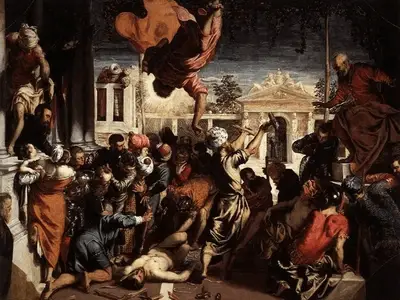Title of Artwork: “The Miracle of St Mark Freeing the Slave”


Artwork by Tintoretto
Year Created 1548
Summary of The Miracle of St Mark Freeing the Slave
Tintoretto’s future father-in-law, Marco Episcopi, was Grand Guardian of the Scuola Grande di San Marco in 1548, and this picture is the first in a series of commissions for the institution.
The theme of the massive painting is the miraculous appearance of St. Mark to save one of his worshippers, the servant of a knight of Provence who was sentenced to have his legs crushed and his eyes put out for worshipping the relics of St. Mark against the desire of his master.
The semicircular arrangement of onlookers around the painting’s protagonists—the foreshortened figure of the slave lying on the ground, the dumbfounded executioner holding aloft the broken implements of torture, the knight of Provence starting up from his seat out of the shadows and into the light—suggests that the scene is taking place on a kind of proscenium, which seems to force the action out of the painting and towards the spectator. Saint Mark, on the other hand, descends from the sky.
All About The Miracle of St Mark Freeing the Slave
Despite taking place in a lavish Roman courtyard, the whole structure of The Miracle of the Slave is fraught with tension. Three separate times, the executioner has tried to carry out the sentence, but each time, the tools have broken before the slave could be injured.
This is the work of Saint Mark, who, in a spectacular fashion, comes down from heaven dressed in a crimson robe and a billowing orange cape to save the slave and spare him the agony of this horrible death. The master of the slave is also converted to Christianity by this miracle.
Tintoretto clearly owes a large debt to Michelangelo, whose influence can be seen here in the work’s strong, muscular figures, which are arranged in a variety of intricate poses. Tintoretto may or may not have used Michelangelo’s sculptural maquettes or other works based on the originals as reference for his own works, but this is debated by experts.
However, this painting had a significant impact on Tintoretto’s career despite some of the early criticism he received for the rapidity with which he worked, as evidenced by the loose and gestural brushwork.
After completing work for the Confraternity of Scuola Grande di San Marco, the artist gained widespread recognition and was soon inundated with commissions.
Tintoretto’s biographers state that when certain members of the confraternity fought against receiving the gift, the artist became so angry that he retreated to his workshop.
As time went on, however, Tintoretto and his supporters were able to silence their critics, and the painting was hung to widespread praise. The adoption of this piece was essential in allowing the Venetian School to experiment with new forms of expression.
Here, Tintoretto offered a highly theatrical treatment of a sacred topic, complementing Titian’s more conventional methods and therefore laying the groundwork for the later development of Baroque painting.
Information Citations:
En.wikipedia.org, https://en.wikipedia.org/.

























